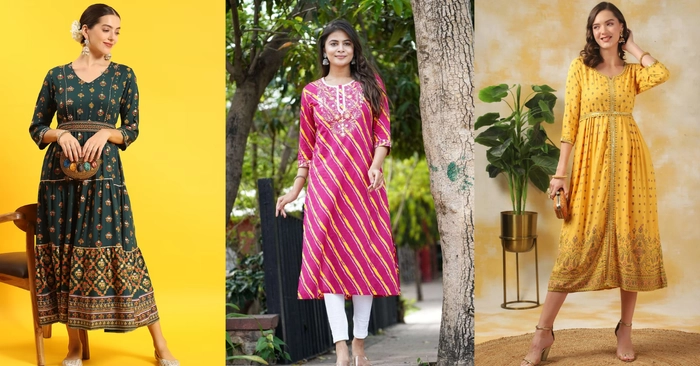In the fashion industry, comfort and style can coexist harmoniously. When it comes to ethnic wear, striking the perfect equilibrium between the two elements can prove to be difficult. But with the introduction of rayon ethnic clothes, that has changed significantly. This fabric revolutionized the way we view ethnic clothing and traditional fashion by offering comfort and breathability to the wearer. Women’s ethnic rayon garments are a perfect example of traditional fashion that incorporates modern touches.
The Rise of Rayon in Ethnic Fashion
A Brief History of Rayon
The term artificial silk is synonymous with rayon, an industrial fabric that was created in the late nineteenth century. Rayon was developed to replace natural silk and became quite popular because of its silk-like properties and affordability. With the growing years, the textile industry advanced, and the production process became more refined. This enabled more and more people to utilize the fabric, making it a common option for ethnic clothing.
The Perfect Piece For Ethnic Designs
Because of its distinctive characteristics, rayon makes for an exceptional fabric choice for ethnic clothing. Its fabrics’ ability to flow great allows for the construction of beautiful flowing shapes that are needed in traditional clothing. Rayon ethnic garments such as sarees and kurtis show off the cultural flowers and designs associated with ethnic clothing whilst providing comfort to the wearer.
The Comfort Factor: Reasons Why Rayon Is Unique
Breathability At Its Best
One of the notable benefits of wearing ethnic clothing and rayon is for sure its breathability. This characteristic becomes even more crucial when talking about ethnic wear, particularly in warmer areas. Rayon enables the best airflow possible which makes the wearer feel cool and comfortable even when wearing the fabric for extended periods of time. This makes it a good fit for festival and wedding gatherings or any event where comfort is needed as much as style.
Moisture Wicking Properties
Rayon also has the ability to effectively absorb moisture, which makes it stand apart from other fabrics. Because rayon is so absorbent, it has the ability to draw moisture away from the skin, so the fabric will not stick to the body even when the conditions are humid. For those who love dancing during weddings or festive celebrations, rayon ethnic wear is the best solution that keeps you fresh throughout the event.
Versatile Style Appeal of Rayon Ethnic Wear
Changing With The Times
The use of rayon is versatile, which means a designer can play with different styles and forms. Want to look modern or traditional? Ethnic wear made using rayon can serve a variety of purposes. From classical anarkali suits to modern fusion sarees and palazzo sets, rayon compliments every design style.
Wide Range Of Colors
Rayon dyes admirably, which opens possibilities of using different colors and prints. Such features are important for ethnic wear that needs different bold colors and patterns. Specialty rayon ethnic wear is available in every color, ranging from bold and deep shades to soft pastel colors, making it easy to select an outfit for any occasion.
Sustainability Aspects of Rayon
Production With A Green Thumb
The growing concern for the environment has allowed consumers to be selective with how they spend their money. When produced responsibly, rayon can be an eco-friendly choice. Some types of rayon are made from wood pulp that is sustainably sourced, as well as environmentally friendly closed-loop production systems. This aspect of rayon production meets the increased demand for sustainable fashion in ethnic wear.
Resilience and Sustainability
Rayon’s durability is a big part of what makes ethnic wear—garments constructed out of different fabrics—sustainable. If you maintain and care for your rayon ethnic wear properly, you won’t need to replace them often, which is cost-effective. This type of slow fashion encourages consumers to make thoughtful purchases. It gives new meaning to quality over quantity.
Maintaining Rayon Garments
Washing Ethics
Those who wish to maintain the beauty and comfort of their outfits must know how to deal with care. Rayon garments should be washed with care. If washing machine use is a must, a delicate setting is best. Stain fighting chemicals should be avoided altogether to help retain the garment’s integrity.
How to Avoid Damaging
How rayon ethnic wear is kept can greatly affect its quality and, therefore, its overall shape. While it is light weight, a yourkurti should be folded. Longer dresses and sarees, being heavier, should be hung. To keep these ethnic clothes from losing color and fabric strength, they should be kept in a dry area out of direct sunlight.
Future Considerations of Rayon Fabric in Ethnic Fashion
Rayon will undoubtedly be a dominant fabric in ethnic fashion. In addition, for consumers and designers alike, rayon’s comfort, style, and sustainable properties make it a desirable fabric. The new innovations in rayon and textile technology production will bring further changes in the realm of ethnic fashion.
To conclude, wearing ethnic rayon clothing is an example of wearing something timeless yet modern and, for the style-conscious individual, a comfortable and eco-friendly piece of cultural clothing. In the future, when comfort meets style, brands such as FabPotli will lead the way with a wide variety of rayon ethnic clothing that meets the needs of eco-conscious and fashionista consumers. Adopting Rayon in ethnic clothing is a trend, but it's also the opportunity to pave the way towards embracing comfort, style, and sustainable fashion.

